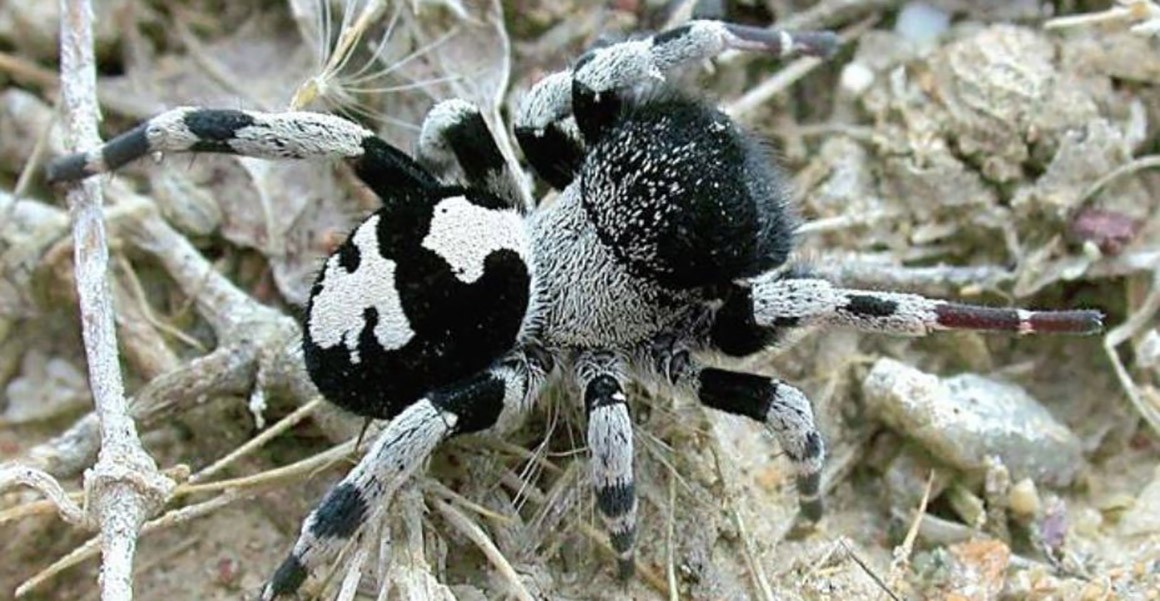Create a list of articles to read later. You will be able to access your list from any article in Discover.
You don't have any saved articles.

The males of the new species have a striking black and white colouration © Henriques et al. 2018
A new species of monochromatic arachnid has been described from the only desert in mainland Europe.
Restricted mostly to Andalusia and the southeastern coast of Spain, the new species has been named Loureedia colleni and is described in the journal Revista Ibérica de Aracnología.
The tiny spider is found in the arid hills and coastal regions of southern Spain, where it lives in burrows underground.
It belongs to the genus Loureedia, named after the singer and former lead guitarist of the Velvet Underground.
Scientists bestowed the name on these spiders because they are known as velvet spiders (thanks to their furry bodies) that live underground.
Sérgio Henriques, a researcher at the Zoological Society of London's Institute of Zoology and main author of the study, says, 'The Loureedia genus is known from Africa and the Middle East, but this is the first time that the genus has been found in Europe.
'This is the only species from the group that is black and white. So while other species have a bright red colouration, this one is more discreet.'

The female Loureedia colleni are more subtle but no less beautiful than the males © Henriques et al. 2018
Despite its more muted palette, Sérgio is quick to point out that this might only be how humans see the spiders. 'For example, we're not sure if predators will see them in the same way,' he says.
By using the Museum's extensive collection of arachnids, Sérgio was not only able to confirm that L. colleni was a new species, but also expand the range of other spiders in the Loureedia genus. He was also able to use the Museum's 3D Visualisation Laboratory to take high-resolution photographs of the specimens.
While the spiders live in short burrows, they also make a small, tented web that forms a funnel above ground, on which they hunt. But what goes on beneath this web?
'The spiders keep what is known as a trophy wall,' explains Sérgio.
'If the spiders left the remains of their prey outside, it would make their nest more obvious and predators like wasps would find it and kill the spider. Because of this they hide the remains of prey on the "ceiling" of their tent webs and collect little trophies of many of the animals that they have killed.'

As velvet spiders that live underground, the genus has been named after Lou Reed © Henriques et al. 2018
This reveals to the researchers that the arachnids have a taste for small beetles belonging to the Tenebrionidae family.
Observing this new species also informed the researchers about the behaviour of the more well-known Loureedia spiders found in Africa and the Middle East.
The known spiders that belong to Loureedia are adapted to hot, arid environments. Sérgio does not expect that any other species from this genus will be found in other parts of Europe simply because this habitat is so rare and far away from the known range of the rest of the group.
'We can never be certain, but we have a very strong suspicion that this is the first and only species of Loureedia in Europe,' explains Sérgio. The genus is diverse across the rest of its range, but it is likely that in the past they only made a single crossing of the Mediterranean.

The spiders are found mainly along Spain's southern coast © Henriques et al. 2018
'I think it's a fairly old species, and I suspect that it arrived in Spain six million years ago,' continues Sérgio. This is when the Strait of Gibraltar closed and the Mediterranean partly dried up, allowing lots of animals to cross from Africa to Europe
'When it got stranded in Spain it became a new species. That is what we think, but again that is only a theory.'
One of the biggest threats to the new species is the insatiable development that is spreading along the southern coast of Spain. Some of this is to keep up with the increasing number of tourists, but it is also for an ever-growing agricultural industry.
The largest concentration of greenhouses in the world is in southern Spain. Despite being one of the hottest and driest regions in Europe, the greenhouses near Almeria cover an area of roughly 350 square kilometres and are thought to supply over half of Europe's demand for fresh fruit and vegetables.

Despite being one of the driest regions in Europe, it is the location for the world's largest concentration of greenhouses © Novikov Aleksey/Shutterstock
'There is a massive area that has been completely devastated,' says Sérgio. 'The spiders are found around the margins of the large greenhouse cluster so probably did live there, but all that is now lost.'
The other major factor is climate change. While we tend to think of a warming climate primarily affecting those species well adapted to cold environments, it will also significantly impact those at the opposite end of the scale.
The spider already lives in temperatures that are at the threshold of what they can tolerate heat-wise. If the climate warms even just a little some will likely die. If heatwaves occur more frequently, Sérgio expects they could have very serious consequences for many populations of the arachnids in southern Spain.